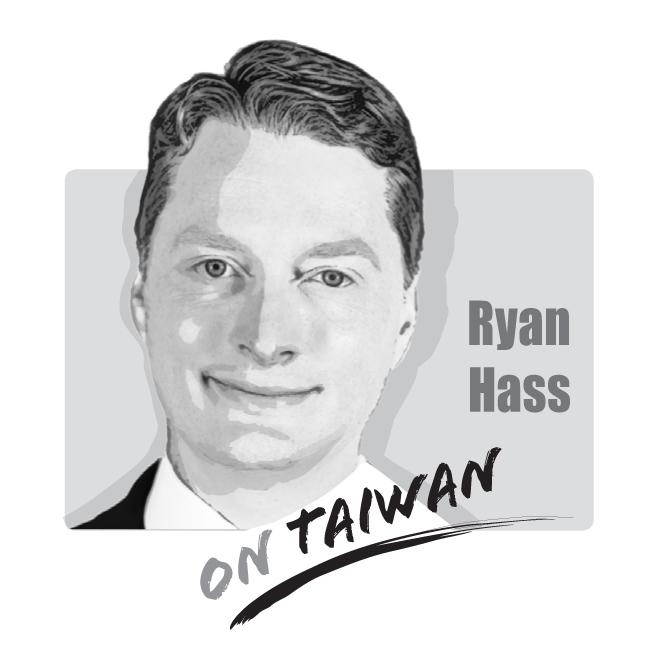There has been a dizzying number of doomsday predictions about Taiwan’s fate in recent months. Former American officials have been forecasting Chinese military actions against Taiwan. Historians and grand strategists have been offering breathless analogies about Taiwan as Suez, Dunkirk, Cuba, or Kuwait. A prominent magazine even has described Taiwan as “the most dangerous place on earth.”
Meanwhile, life in Taiwan has returned to normal after the outbreak of COVID-19 much faster than just about anywhere else. Taiwan’s leaders, most notably President Tsai Ing-wen (蔡英文), have remained calm and steady. Taiwan’s economy has been roaring. And Taiwan’s relevance to the rest of the world has gained greater appreciation; as the recent global shortage in semiconductors has awakened leaders everywhere to the critical role Taiwan and its firms play in powering the global economy.
What accounts for this strange split-screen between Taiwan’s lived reality and the anxiety many outside of Taiwan ascribe to it? Much of the alarm owes to Beijing’s impatient assertiveness in pursuit of its ambitions. Beijing has rattled its sabers more loudly around Taiwan. It also has trampled Hong Kong’s autonomy, drawn blood at the Sino-Indian border, increased its military and paramilitary presence in the South China Sea, and continued to expand its investments in force projection capabilities that could be used in a Taiwan conflict.

Some Western analysts fear Taiwan’s public is insufficiently concerned by China’s growing military capabilities. A greater public awareness of the threat Taiwan confronts, they believe, could lead to greater political support for increased investments in defensive capabilities. These arguments often ignore that Taiwan’s defense spending as a share of overall government spending has remained consistent, even as the PLA has grown stronger over the last two decades. In other words, merely raising rhetorical alarms is unlikely to scare Taiwan into spending more on national defense.
Many historians and grand strategists have fallen into their habit of searching for historical parallels to explain Taiwan’s current predicament. This has led to tortured historical analogies. It also frequently has been accompanied by a habit among big thinkers of treating Taiwan solely as an object of great power rivalry, rather than recognizing the views of its 23 million people as the decisive factor in determining Taiwan’s future.
These are more than academic problems, though. Those who highlight Taiwan’s vulnerabilities without offering constructive remedies to them are helping Beijing weaken the psychological confidence of the people of Taiwan in their future. They also raise the risk profile of Taiwan, potentially complicating Taiwan’s ability to attract foreign capital and talent. Beijing prefers Taiwan to feel isolated and vulnerable. Beijing wants to feed a perception that Taiwan’s only path to security, prosperity, and dignity on the world stage is through unification with the mainland, or at a minimum, taking steps that tie Taiwan closer to the mainland.
Fortunately, these dynamics are well understood by President Tsai and President Biden. Both leaders have been dealing with cross-Strait issues for decades. They each have their own feel for the situation. Each has confidence in the intentions of the other. Neither of them will provide cause for Beijing to resort to force. Both will be measured, thoughtful, and coordinated in responding to challenges presented by Beijing’s behavior.
President Biden and Japanese Prime Minister Suga sent a clear signal of the importance both countries assign to preserving stability in the Taiwan Strait when Suga visited the White House last month. Their joint leader’s statement underscored the importance of peace and stability across the Taiwan Strait and encouraged peaceful resolution of cross-Strait issues, marking the first time Taiwan had appeared in a US-Japan joint leader’s statement since Japan’s normalization of relations with China in 1972. Such unity between the world’s first and third largest economies about Taiwan’s importance helps undermine any efforts to isolate it.
The United States also has maintained a steady military presence around Taiwan in recent months, even as senior American officials have emphasized that the United States does not seek to enter a “new Cold War” or engage in conflict with China. Such a posture reflects America’s determination to preserve open access in Asia and uphold the credibility of its security commitments to partners and allies, even as it manages forthrightly points of friction with Beijing.
Such efforts do not solve Taiwan’s problems, but they give Taiwan’s leaders space to strengthen their own situation. As my Brookings colleague Richard Bush has observed in his important new book, Difficult Choices: Taiwan’s Quest for Security and the Good Life, Taiwan must overcome several major obstacles. These include raising more government funds to meet social and security requirements, energy reform, transitional justice, strengthening economic competitiveness, and forging greater political unity for dealing with pressure from Beijing.
Taiwan also has contributions to offer to challenges confronting the international community, from green technology to countering disinformation, pandemic preparedness to women’s empowerment. The more successful Taiwan becomes in strengthening itself and delivering solutions to challenges confronting the international community, the less vulnerable to Chinese coercion it will be. After all, the people of Taiwan have agency in their own future. Let that be the story future historians tell.
Ryan Hass is a senior fellow and the Michael H. Armacost Chair in the Foreign Policy program at Brookings, where he holds a joint appointment to the John L. Thornton China Center and the Center for East Asia Policy Studies. He is also the Interim Chen-Fu and Cecilia Yen Koo Chair in Taiwan Studies.

In the past month, two important developments are poised to equip Taiwan with expanded capabilities to play foreign policy offense in an age where Taiwan’s diplomatic space is seriously constricted by a hegemonic Beijing. Taiwan Foreign Minister Lin Chia-lung (林佳龍) led a delegation of Taiwan and US companies to the Philippines to promote trilateral economic cooperation between the three countries. Additionally, in the past two weeks, Taiwan has placed chip export controls on South Africa in an escalating standoff over the placing of its diplomatic mission in Pretoria, causing the South Africans to pause and ask for consultations to resolve
An altercation involving a 73-year-old woman and a younger person broke out on a Taipei MRT train last week, with videos of the incident going viral online, sparking wide discussions about the controversial priority seats and social norms. In the video, the elderly woman, surnamed Tseng (曾), approached a passenger in a priority seat and demanded that she get up, and after she refused, she swung her bag, hitting her on the knees and calves several times. In return, the commuter asked a nearby passenger to hold her bag, stood up and kicked Tseng, causing her to fall backward and
In December 1937, Japanese troops captured Nanjing and unleashed one of the darkest chapters of the 20th century. Over six weeks, hundreds of thousands were slaughtered and women were raped on a scale that still defies comprehension. Across Asia, the Japanese occupation left deep scars. Singapore, Malaya, the Philippines and much of China endured terror, forced labor and massacres. My own grandfather was tortured by the Japanese in Singapore. His wife, traumatized beyond recovery, lived the rest of her life in silence and breakdown. These stories are real, not abstract history. Here is the irony: Mao Zedong (毛澤東) himself once told visiting
When I reminded my 83-year-old mother on Wednesday that it was the 76th anniversary of the founding of the People’s Republic of China, she replied: “Yes, it was the day when my family was broken.” That answer captures the paradox of modern China. To most Chinese in mainland China, Oct. 1 is a day of pride — a celebration of national strength, prosperity and global stature. However, on a deeper level, it is also a reminder to many of the families shattered, the freedoms extinguished and the lives sacrificed on the road here. Seventy-six years ago, Chinese Communist leader Mao Zedong (毛澤東)